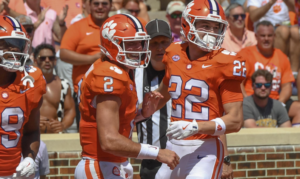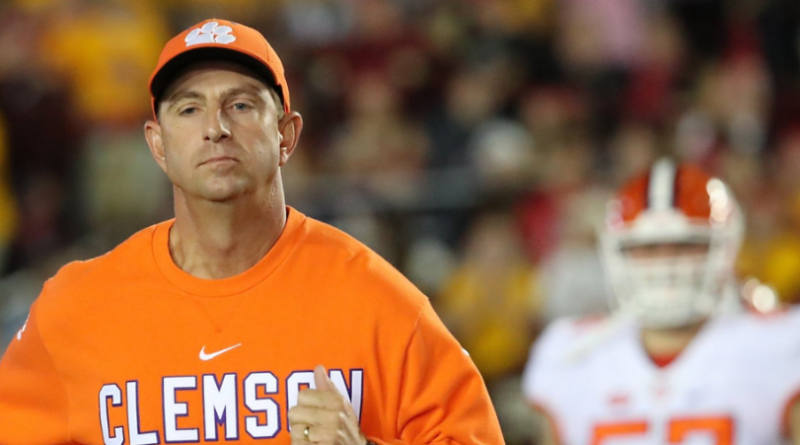A look at Clemson football’s QB hot board as the Tigers look to replace Blake Hebert in 2025 class
Clemson Football’s QB Hot Board as They Eye Hebert’s Replacement
Who could Clemson try to track down late in the process?

Clemson football is at a critical juncture as it looks to navigate the recruiting landscape following the recent decommitment of quarterback Blake Hebert, who flipped to Notre Dame just a week ago. This unexpected turn of events has left the Tigers searching for a new signal-caller to bolster their 2025 class. With head coach Dabo Swinney publicly stating the team’s intent to secure a quarterback, the focus now shifts to potential candidates and strategies in the wake of this setback.
The loss of Hebert was particularly impactful, not just because of his talent, but also due to his role as a key recruiter within the class. Hebert had been instrumental in attracting other prospects to Clemson, and his departure could have ripple effects on the Tigers’ overall recruiting efforts. Despite this, Swinney and his staff remain optimistic about finding a suitable replacement who can step in and make an immediate impact.
Currently, Clemson has a solid foundation with three quarterbacks: Cade Klubnik, Christopher Vizzina, and Trent Pearman. Klubnik has already shown flashes of brilliance, throwing for 24 touchdowns and demonstrating leadership on the field. Vizzina is seen as the future of the program, with considerable potential to take over once Klubnik graduates. Pearman adds depth to the roster, but as Swinney noted, the focus is now on finding someone who can contribute as a fourth option, either through the transfer portal or via late high school recruitment.
As Clemson evaluates its options, the likelihood of pursuing a graduate transfer seems increasingly plausible. The timing of Hebert’s decommitment has narrowed the window for high school prospects, many of whom are already committed or preparing to transition to campus life. Therefore, targeting players with whom the coaching staff has existing relationships may yield the best results.
One key player to consider is George MacIntyre, who is also committed elsewhere but has ties to the Clemson program. Although the chances of flipping him may be slim, the coaching staff could explore this avenue. MacIntyre is known for his strong arm and ability to read defenses, attributes that would complement Clemson’s offensive style well. If he were to entertain a visit or discussions with Clemson, it would certainly add intrigue to the recruitment process.
Another name that has surfaced in discussions is Walker White, a four-star quarterback from Little Rock, Arkansas. White has been on Clemson’s radar for some time, and while he is currently committed to Auburn, the shifting dynamics in college football recruiting mean that players often reassess their commitments. White has an impressive skill set and has demonstrated the ability to make plays both in the pocket and on the move. His experience and versatility could make him an attractive option for the Tigers.
In addition to MacIntyre and White, Clemson may consider looking at other quarterbacks who have had interactions with the program during visits or camps. For instance, some players may have previously attended Clemson’s elite camps, giving the coaching staff insight into their abilities and fit within the program. This prior connection can be crucial, especially in late-stage recruiting scenarios where the clock is ticking.
As the Tigers weigh their options, they must also consider the implications of their decision on their existing quarterback depth chart. The prospect of adding a transfer could shake things up, especially for younger players like Vizzina and Pearman, who may feel the pressure to compete against a seasoned transfer. However, the coaching staff believes that healthy competition can foster development and ultimately strengthen the program.
Clemson’s recruiting strategy must also align with its offensive philosophy. Swinney has always favored quarterbacks who possess not only the arm talent but also the intelligence and adaptability to run a dynamic offense. The Tigers have a history of developing quarterbacks who can thrive under pressure, and the next signal-caller must fit this mold.
Moreover, it’s essential to examine the potential impact of Clemson’s offensive scheme on the quarterback they bring in. The Tigers have emphasized a balanced approach, integrating both the passing and running game effectively. The incoming quarterback should ideally be proficient in reading defenses and making quick decisions, as this will be critical to executing Swinney’s vision for the offense.
One possibility is to look at dual-threat quarterbacks who can make plays with both their arm and legs. This type of player could add an extra dimension to the offense, creating mismatches against opposing defenses. A quarterback with dual-threat capabilities would also allow for greater flexibility in play-calling, opening up various options that can be tailored to different opponents.
As Clemson evaluates its needs, they must also consider the broader context of college football recruiting. The transfer portal has become an essential aspect of roster management, allowing programs to address immediate needs without having to rely solely on high school recruiting. The success of recent transfers across the country has made this route increasingly appealing for programs like Clemson, who are looking to stay competitive in a rapidly evolving landscape.
Clemson’s coaching staff has proven adept at identifying and nurturing talent, and the coming weeks will be critical in determining who they target. Their success in securing a quarterback who can complement the existing roster and adapt to the demands of the SEC will be crucial in maintaining the program’s competitive edge.
However, Clemson football finds itself in a pivotal moment following the decommitment of Blake Hebert. As the Tigers look to fill this crucial position in their 2025 recruiting class, they must navigate a challenging landscape. With existing quarterbacks like Cade Klubnik, Christopher Vizzina, and Trent Pearman on the roster, the focus will likely shift towards identifying a graduate transfer or exploring relationships with high school prospects who have previously interacted with the program.
Names like George MacIntyre and Walker White represent potential targets, but the coaching staff must also remain flexible and open to other options that arise in the coming weeks. Ultimately, the goal is to secure a quarterback who can not only contribute to the team’s immediate needs but also align with Clemson’s long-term vision for success. The outcome of this search will significantly impact the program’s trajectory as it seeks to reclaim its position among the elite in college football. The clock is ticking, and as Clemson continues its quest for a new signal-caller, every decision made in the coming weeks will be critical.
